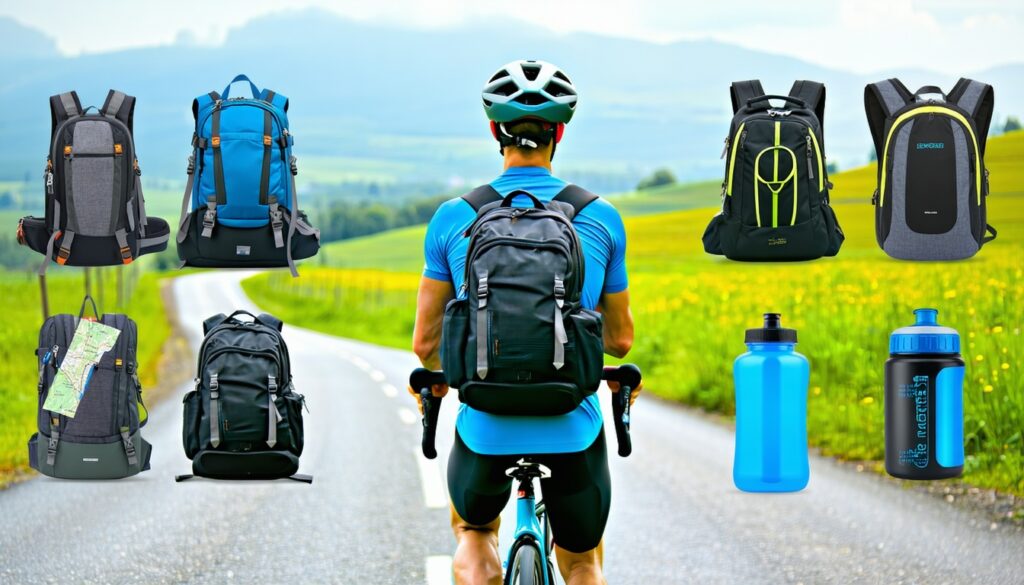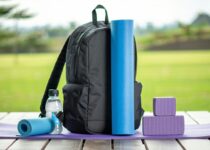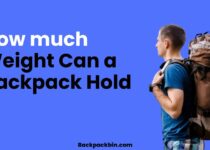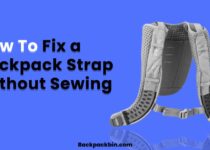How to Choose a Backpack for Long-Distance Touring by Bike

Choosing a Cycling Backpack
Selecting the right cycling backpack is essential for comfort and efficiency during rides. It is important to consider both capacity and features alongside comfort and fit when making a choice.
Capacity and Features
Cycling backpacks typically offer between 20 and 30 liters of storage capacity. This range provides a good balance between weight and space, allowing cyclists to carry essentials without feeling weighed down. Some of the features commonly available in cycling backpacks include:
| Feature | Description |
|---|---|
| Organizers | Compartments for laptops and other gear |
| Waist and Chest Straps | Additional support to distribute weight evenly |
| Waterproofing | Protection for items during rainy conditions |
| Hydration Sleeve | Space for a water reservoir or bottle |
For instance, the CamelBak MULE Commute 22 offers a weatherproof roll-top sleeve for laptops and A4-sized notebooks, along with an air channel back panel for added ventilation and side pockets suitable for a D-lock. Meanwhile, the Rapha Travel Backpack features a 25-liter capacity, reflective waterproof nylon, and multiple organizer compartments, making it practical for daily commutes and travel.
Comfort and Fit
Comfort remains a significant factor when choosing a cycling backpack. Key elements to consider for fit include:
- Wide, Padded Straps: Help to distribute weight and reduce strain on shoulders.
- Padded and Ventilated Back: Essential for carrying larger loads comfortably, preventing discomfort during long rides.
- Additional Waist and Chest Straps: These can improve stability and comfort, especially while on bumpy terrains.
The primary use for many cycling backpacks is commuting, so they should be designed to be worn comfortably while carrying essential items like laptops and spare clothing. Waterproofing adds an important feature for those who ride in varied weather conditions.
By considering the capacity and features along with comfort and fit, cyclists can find a backpack that enhances their riding experience. For more detailed guidance on specific types of backpacks, explore our resources on how to choose an ergonomic cycling backpack for comfort and posture and why ventilated back panel matters in a cycling backpack.
Considerations for Bikepacking Backpacks
Choosing the right backpack for long-distance bike touring is essential for a comfortable and enjoyable experience. Two key factors to consider are versatility of use and weight distribution.
Versatility of Use
A typical bikepacking setup might not provide enough space for all necessary items, especially for long-distance touring trips. In such cases, a backpack can be a crucial addition to carry extra layers, water, or food between resupply points. When selecting a backpack, cyclists should look for features that accommodate versatile use, allowing for adjustments based on different riding conditions.
| Feature | Description |
|---|---|
| Expandable Storage | Useful for carrying extra gear without bulk. |
| Hydration Compatibility | Check for hydration sleeves to store water bladders (hydration-compatible cycling backpacks: what to look for). |
| Weather Resistance | Ensures contents stay dry during unpredictable weather. |
Weight Distribution
Weight distribution is critical for maintaining balance and comfort during long rides. Traditional backpacks typically spread weight in a vertical orientation, which can be effective but may not suit everyone’s needs. Conversely, ‘lowrider’ backpacks transfer weight lower down, shifting the center of gravity closer to the hips. This design can enhance stability and reduce strain on the back and shoulders, especially when carrying heavier loads of food and water.
| Backpack Type | Weight Distribution | Benefits |
|---|---|---|
| Traditional Backpack | Vertical Orientation | Even weight spread, suitable for short trips. |
| Lowrider Backpack | Hip Level | Lower center of gravity, improved comfort for long rides. |
When considering a backpack, it’s vital to assess strap design, adjustability, lumbar support, and back padding for optimal comfort while cycling. These features can significantly enhance the riding experience, allowing cyclists to focus on their journey rather than discomfort. Exploring packs with features designed for comfort, such as sternum and waist straps as well as ventilation, can also provide lost relief during extended use (how to choose an ergonomic cycling backpack for comfort and posture).
Popular Cycling Backpack Brands
When selecting a backpack for long-distance bike touring, understanding the options available from reputable brands can greatly assist cyclists in making an informed decision. Here are some popular cycling backpack brands worth considering:
CamelBak MULE Commute 22
The CamelBak MULE Commute 22 backpack is specifically designed for commuters. It offers a weatherproof roll-top sleeve suitable for a laptop or an A4-sized notebook. Additional features include:
| Feature | Description |
|---|---|
| Pockets | Arm harness pockets on each strap for easy access |
| Back Panel | Air channel back panel for ventilation |
| Side Pockets | Holds items like a D-lock, enhancing convenience |
This stylish and weather-resistant option fulfills the needs of daily cyclists.
Rapha Travel Backpack
The Rapha Travel Backpack boasts a capacity of 25 liters and features a reflective waterproof nylon exterior. Key characteristics include:
| Feature | Description |
|---|---|
| Organization | Includes main compartments and a padded laptop pocket |
| Security | Pockets for valuables with padlock-friendly zip loops |
| Comfort | Well-padded straps and reflective coating for visibility |
This backpack is ideal for cyclists seeking comfort alongside functionality.
Ortlieb Commuter Daypack Urban Line
Designed for urban riders, the Ortlieb Commuter Daypack Urban Line is a rugged backpack with a storage capacity of 27 liters. Here’s what it offers:
| Feature | Description |
|---|---|
| Waterproof | Completely waterproof, ensuring protection from the elements |
| Storage | Large padded pocket for devices and one spacious main compartment |
| Comfort | Offers comfort and ventilation for extended wear |
This option is well-suited for daily use while maintaining durability.
Deuter Amager 25+5
The Deuter Amager 25+5 backpack is engineered to be high-quality and durable, reflecting German craftsmanship. Notable features include:
| Feature | Description |
|---|---|
| Capacity | Designed with a 25+5 liter capacity for extra storage |
| Comfort | Excellent detailing and comfort for long rides |
| Limitations | Lacks a side pocket for a water bottle, which may be a drawback |
Despite this minor inconvenience, it stands out for its overall performance.
These brands provide a range of options tailored to various cycling needs, making them strong contenders for anyone considering how to choose a backpack for long-distance touring by bike.
Recommendations for Bikepacking Backpacks
Choosing the right backpack is crucial for any cyclist embarking on long-distance tours. Each of the following backpacks has been evaluated for its unique features and benefits suited for bikepacking.
Acre Hauser 10L
The Acre Hauser 10L is an excellent choice for bikepacking, as it caters to various preferences and needs. This backpack is well-regarded for its weatherproofing, comfort features, effective weight distribution, hydration capacity, and compressibility.
| Feature | Details |
|---|---|
| Capacity | 10L |
| Weather Resistance | Yes |
| Hydration Compatible | Yes |
Talon 11 by Osprey Packs
The Talon 11 by Osprey Packs is recognized for its suitability in trail riding and offers exceptional water-carrying capabilities. Its lightweight design makes it ideal for both bikepacking trips and long day rides, ensuring comfort throughout the journey.
| Feature | Details |
|---|---|
| Capacity | 11L |
| Weight | Lightweight |
| Water Reservoir Included | Yes |
Wingnut Enduro
The Wingnut Enduro backpack is another fantastic option catering to trail riders. Known for its comfortable water-carrying capabilities, this backpack is perfect for those long bikepacking trips and day rides that demand efficient hydration.
| Feature | Details |
|---|---|
| Capacity | 16L |
| Comfort Level | High |
| Hydration Compatible | Yes |
Camelbak Skyline 10LR
The Camelbak Skyline 10LR is a stylish and weather-resistant option, making it suitable not only for commuters but also for various bikepacking adventures. Its design provides a reliable solution for cyclists who need both functionality and aesthetics.
| Feature | Details |
|---|---|
| Capacity | 10L |
| Weather Resistance | Yes |
| Hydration Integrated | Yes |
Selecting the right backpack can greatly enhance the biking experience. Whether prioritizing hydration, comfort, or weather resistance, any of these recommended backpacks could serve as a solid choice for avid cyclists exploring long-distance routes. For tips on finding the best pack for your touring needs, refer to our guide on how to choose a backpack for long-distance touring by bike.
Types of Backpacks for Bikepacking
Selecting the right type of backpack is essential for bikepacking. There are two primary designs to consider: traditional vertical orientation and ‘lowrider’ weight distribution. Understanding the differences can help cyclists choose the best option for long-distance touring.
Traditional Vertical Orientation
Traditional backpacks are designed with a vertical orientation, which means they spread the weight evenly along the back. This design is common among standard hiking and cycling backpacks. The vertical structure helps keep the center of gravity higher, which can be beneficial for maintaining balance while riding. However, it may cause strain on the shoulders and back, especially during prolonged use.
| Feature | Traditional Vertical Orientation |
|---|---|
| Weight Distribution | Centered along the spine |
| Comfort Level | Varies based on adjustability and strap design |
| Ideal for | Shorter trips or when heavy items are not carried |
Traditional backpacks often include adjustable straps, lumbar support, and back padding to enhance comfort. Cyclists should ensure that the pack fits well to avoid discomfort during long rides. For more tips on comfort and posture while cycling, check out our guide on how to choose an ergonomic cycling backpack for comfort and posture.
‘Lowrider’ Weight Distribution
‘Lowrider’ backpacks shift the weight lower, distributing it around the hips rather than the shoulders. This design lowers the center of gravity, which can improve stability while cycling. It also allows cyclists to carry larger loads without feeling top-heavy, making it ideal for longer tours where extra gear and supplies are necessary.
| Feature | ‘Lowrider’ Weight Distribution |
|---|---|
| Weight Distribution | Lower on the body, around the hips |
| Comfort Level | Generally reduces shoulder strain |
| Ideal for | Long-distance touring with heavier loads |
This design may incorporate features like a waistband adjustment, allowing for a more tailored fit across the hip area. It is important to choose a ‘lowrider’ backpack that offers good lumbar support and includes features like hydration sleeves for convenience during rides. For more information on hydration-compatible backpacks, check out our article on hydration-compatible cycling backpacks: what to look for.
When choosing a backpack for bikepacking, cyclists should consider their ride duration, type of load, and personal comfort preferences. Whether opting for a traditional vertical orientation or a ‘lowrider’ design, it’s important to ensure that the chosen backpack enhances the overall cycling experience.
Factors Affecting Long-Distance Touring Backpack Choice
When selecting a backpack for long-distance cycling tours, it’s crucial to take various factors into account to enhance comfort and functionality. Two key considerations are heat regulation and ventilation, as well as storage expandability.
Heat Regulation and Ventilation
Heat regulation is vital for comfort during long rides. A well-ventilated backpack can significantly reduce discomfort caused by sweat build-up. Look for backpacks with features like breathable mesh panels or ventilated back systems. This allows air to circulate between the bag and the back, helping to keep cyclists dry and cool. Appropriate ventilation also minimizes the risk of heat exhaustion on warmer rides. For more tips about this aspect, refer to our article on why ventilated back panel matters in a cycling backpack.
Features for Enhanced Ventilation:
| Feature | Description |
|---|---|
| Mesh Back Panel | Promotes airflow and reduces sweat |
| Temperature Control | Materials that dissipate heat |
| Adjustable Straps | Optimize fit to enhance breathability |
Storage Expandability
Storage expandability is essential for long-distance touring as cyclists often need to carry extra gear, food, or layers of clothing for changing weather conditions. A backpack that can expand or has additional compartments can make it easier to manage these varying needs.
Consider backpacks with roll-top closures or zippered expansion features that allow for an increase in capacity without compromising the pack’s shape or balance. This is particularly useful for carrying snacks or gear needed temporarily. Additionally, external mesh sleeves can be handy for stowing items like water bottles or jackets for quick access.
Storage Options:
| Type of Storage | Description |
|---|---|
| Roll-Top Closure | Increases capacity while keeping contents secure |
| Zippered Expansion | Adds space for extra gear easily |
| External Mesh Sleeves | Quick-access storage for frequently needed items |
For a deeper understanding of features in cycling backpacks, check our insights on hydration-compatible cycling backpacks: what to look for and how to pack tools snacks and gear in a bike backpack. Making the right choices in heat regulation and storage can significantly impact the success of a long-distance biking journey.
Features to Look for in a Cycling Backpack
When selecting the right cycling backpack, certain features can greatly enhance the experience for riders. This section highlights two essential features: hydration sleeve availability and external mesh sleeves.
Hydration Sleeve Availability
A hydration sleeve is a valuable feature to consider when determining how to choose a backpack for long-distance touring by bike. Many cyclists prefer to stay hydrated without having to stop frequently, making a backpack with this feature highly beneficial.
| Feature | Importance |
|---|---|
| Allows for hands-free hydration | Essential for long rides |
| Keeps hydration pack separate from gear | Prevents leaks |
| Usually designed for easy access | Convenience during rides |
Many backpacks come with a dedicated compartment for hydration bladders along with drinking tubes that can be routed for easy sipping while cycling. This feature can be particularly helpful for endurance riders or those on long tours.
For more details on hydration-friendly packs, refer to our article on hydration-compatible cycling backpacks: what to look for.
External Mesh Sleeves
External mesh sleeves are another useful feature in cycling backpacks. These compartments can be utilized to store items that need quick access or to carry wet gear separately without compromising the interior of the backpack.
| Use Case | Benefit |
|---|---|
| Storing a water bottle | Easy access while riding |
| Carrying wet clothes or towels | Keeps moisture separate |
| Additional storage capability | Increases packing options |
These mesh sleeves provide airflow, which can be advantageous on warm days, making items within them less prone to odor and mildew. Cyclists can store extra layers or snacks while still keeping them accessible.
If you’re interested in features that enhance visibility or organization, check out our article on why backpacks with cargo nets are useful for cyclists.
Considering these features can significantly improve a cyclist’s experience on long-distance tours. Prioritizing hydration and additional storage capabilities will ensure that a backpack meets the needs of any cycling enthusiast.
Backpacking Pack Options
When selecting the appropriate backpack for long-distance cycling, it’s essential to consider the duration of your trips. Cycling backpacks are generally categorized into three main options based on trip length: weekend packs, multiday packs, and extended-trip packs. Each type has unique features to accommodate various needs and preferences.
Weekend Packs (1-3 Nights)
Weekend packs are designed for short trips, providing enough space to carry essentials for one to three nights. Typically, these backpacks range from 20 to 45 liters in capacity. They are lightweight and compact, making them suitable for cyclists who want to travel light but still carry necessary gear.
| Feature | Description |
|---|---|
| Capacity | 20-45 liters |
| Best For | Short trips up to 3 nights |
| Weight | Lightweight and easy to manage |
| Ideal Use | Weekend trips and quick getaways |
Weekend packs are perfect for cyclists who need to traverse through cities or shorter trails, allowing them to pack efficiently without being weighed down.
Multiday Packs (3-5 Nights)
Multiday packs offer additional storage space for trips spanning three to five nights. Ranging from 40 to 60 liters, these packs provide a balance between capacity and comfort. They often include features such as compartments for organizing gear and hydration reservoirs to keep cyclists hydrated.
| Feature | Description |
|---|---|
| Capacity | 40-60 liters |
| Best For | Trips lasting 3 to 5 nights |
| Weight | Moderate, designed for comfort |
| Ideal Use | Longer touring trips with extra gear |
Multiday packs are excellent for cyclists planning to venture further, providing ample space for camping gear, clothes, and food supplies.
Extended-Trip Packs (5+ Nights)
Extended-trip packs are built for extended cycling adventures, accommodating more than five nights of gear. Typically, these backpacks range from 60 to 70 liters or more, allowing for maximum storage capacity.
| Feature | Description |
|---|---|
| Capacity | 60-70+ liters |
| Best For | Overnight journeys exceeding 5 nights |
| Weight | Heavier, but designed for stability |
| Ideal Use | Long expeditions and bikepacking |
These packs often include additional features for comfort and support, making them suitable for cycling longer distances without compromising on essential gear.
Understanding these pack options is crucial for cyclists looking to optimize their gear for long-distance touring. Each type offers distinct advantages, ensuring that every cyclist can find the right fit for their adventures. To learn more about how to choose a backpack, check out our guide on how to choose a backpack for long-distance touring by bike.


